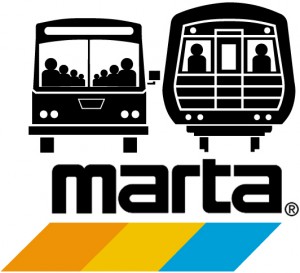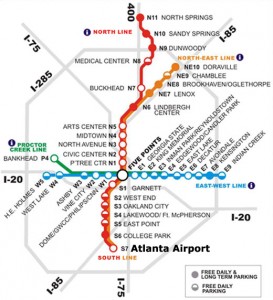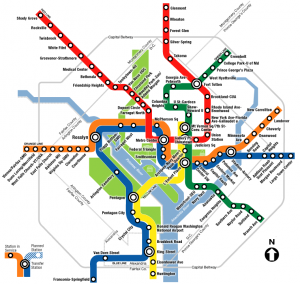MARTA and Atlanta Streetcar Compared to Peer Cities
The other used by most major metropolitan areas to relieve traffic on the roads is public transit, primarily passenger rail. Atlanta is lagging behind its peer cities by a significant margin. The metropolitan area most similar to Atlanta in its public transportation needs is Washington D.C.. These two areas have a similar population, with Atlanta at 5,376,285 residents and D.C. at 5,358,130 residents (as reported in the 2010 Census), as well a similar layout of roads that utilizes a 3-digit Beltline Interstate Route.
You can see that it’s rail system is much more extensive than Atlanta. It has a denser interior consisting of 6 different lines and 10 outer termini for suburbs residents to enter through. It also currently has a new section of the silver line currently under construction, whereas Atlanta’s MARTA hasn’t had any new expansion since 2000 (“Study: Atlanta …”). In that time cities like Washington D.C. have widened the gap between our rapid transit systems even more. Washington D.C. is a good example of how a population of nearly 5 and a half million people can be properly transported with a rail-heavy public transit system.
Another city comparable to Atlanta is the metropolitan area surrounding Portland, Oregon. Portland puts Atlanta’s public transit system to even greater shame. Portland only supports 2,207,462 residents to Atlanta’s 5,376,285, yet has a myriad of public transit options available to its citizens. It is the perfect example of a city that has effectively blended several different types of mass transit to serve different purposes around the city. Portland’s light rail system, MAX (Metropolitan Area Express), has five different lines with a relatively dense core. It also has a “Commuter Rail” which is one of only 3 suburb-to-suburb rail lines in the country. The Aerial Tram is a ski-lift style cableway that Oregon Health and Science University on Marquam Hill to the South Waterfront District. But maybe the most embarrassing aspect of this transit network is Portland’s Streetcar. Portland Streetcar has two lines, with one of them being a loop that is doubled with two routes that run simultaneously (“Portland Streetcar”). Atlanta’s fledgling streetcar system had a ridership of 21,818 riders in January, 2016 (Flynn) while Portland’s streetcar averages almost as much (20,011 riders) in a single weekday (“Portland Streetcar”).



